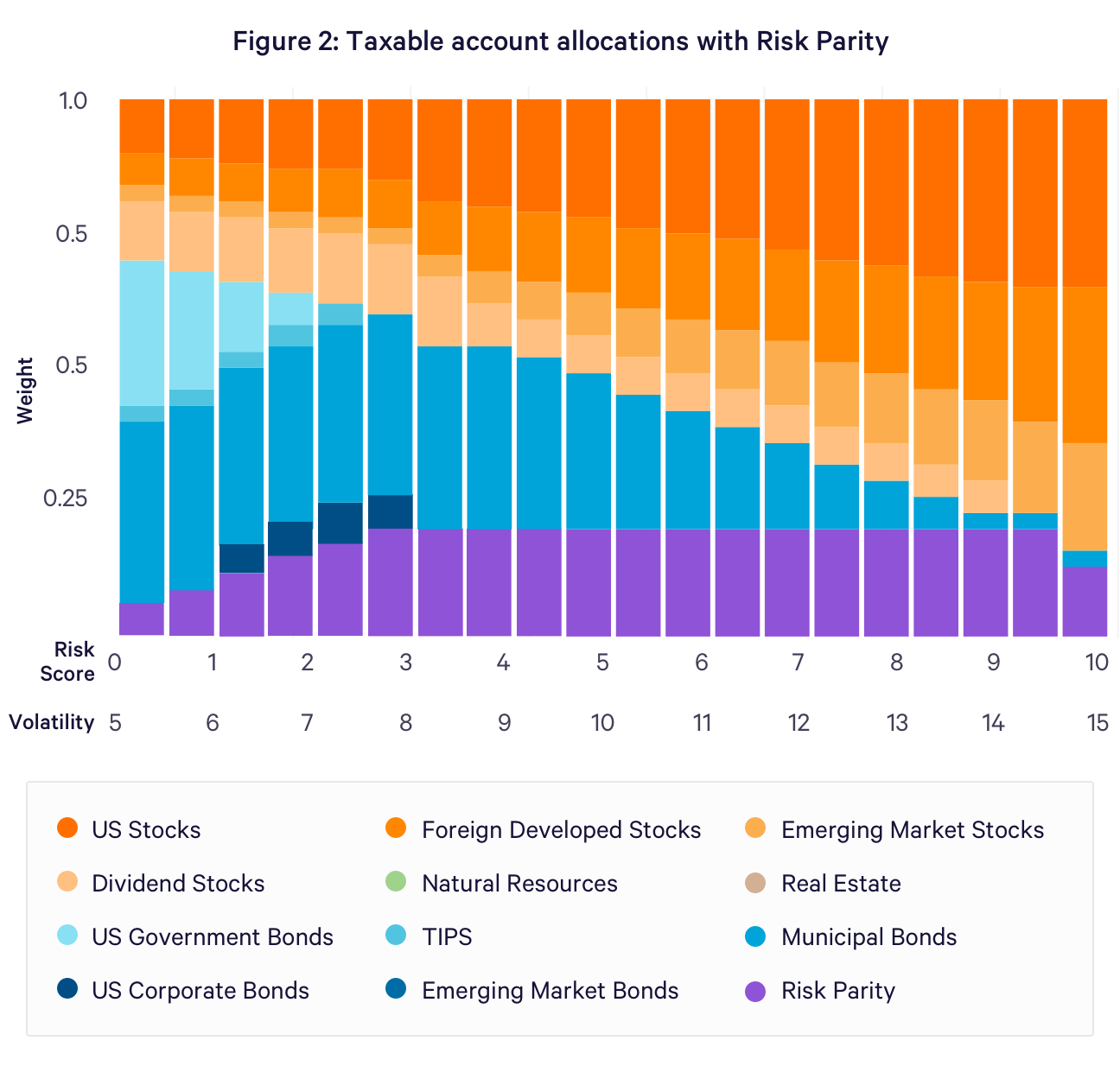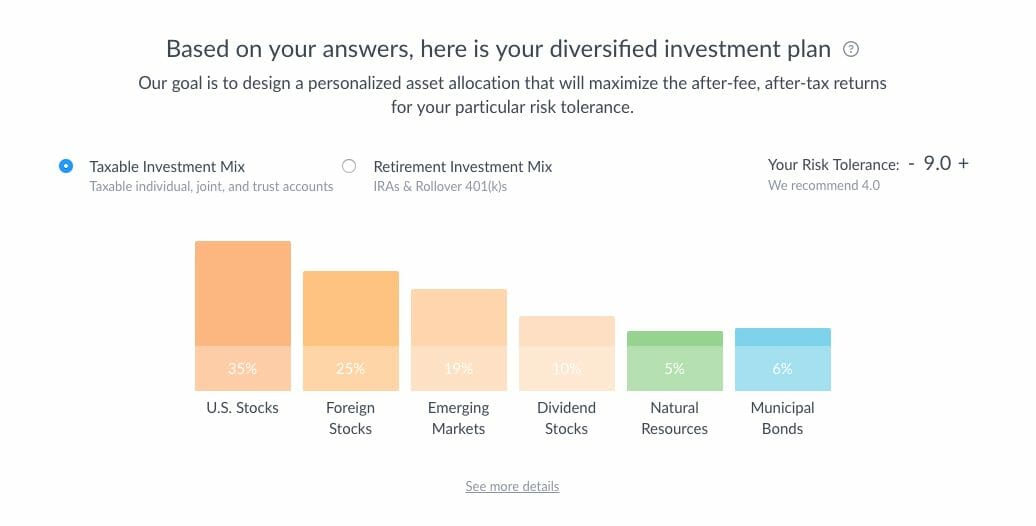Wealthfront is a Robo-Advisor that makes it easier for young investors to get started with the first $5,000 managed for free. They offer investors advanced features like tax-loss harvesting and automatic rebalancing.
Wealthfront is the only service that provides stock-level tax-loss harvesting, a method of investing in the underlying assets of an index that allows investors to save on index management fees while maintaining proper asset allocation.
Wealthfront also provides free financial planning, investment management, and short-term cash management all services that are fully automated.
What features do novice and experienced investors get from Wealthfront? How does Wealthfront stack up against the other Robo-Advisors and what sets them apart? We’ll answer these questions and more in our Wealthfront Review.
Luckily we got an interview with the former Wealthfront CEO Adam Nash. After doing research, chatting with him for nearly two hours and doing a ton more research, we’ve got a pretty good idea of where they stand in the
Remember the epic East Coast vs. West Coast rap battles? In the
If you’re on the East Coast (represent!), you are probably more familiar with
Robo-Advisors are Competing for Your Money
If you’re as excited as I am to have another serious competitor on the scene, this review is for you. In this Wealthfront review, we’re going to break down the good and the bad and suggest where a Wealthfront investment account might fit into your overall investment portfolio.
But first, let’s see how Wealthfront stacks up against their competition:
Minimum Investment:
$500
Management Fees:
0.25%
Promotion:
Invest your first $5,000 free, for life
Tax Loss Harvesting:
Yes
Portfolio Rebalancing:
Yes
Assets Under Management:
$10 billion
Minimum Investment:
$0
Management Fees:
0.25%
Promotion:
Invest free for up to 1 year
Tax Loss Harvesting:
Yes
Portfolio Rebalancing:
Yes
Assets Under Management:
$21 billion
Minimum Investment:
$0
Management Fees:
$1, $2 or $3 a month.
Promotion:
Signup and get $5
Tax Loss Harvesting:
No
Portfolio Rebalancing:
Yes
Assets Under Management:
$1 billion
Check out our full comparison of Acorns vs Betterment vs Wealthfront.
Attracting Digital Natives
There is fierce competition among robo-advisors for young investors aged late 20s to early 40s. People in this age range have a few things in common. They’re roughly Millenials. They save more of their income than those a generation ago at the same age.
Millennials spend a smaller proportion of their income than 25-34-year-olds did a generation ago. In the Reagan era, this age group spent 91 percent of their income. Today’s millennials spend only 81 percent of their income.
They hate talking on the phone. And while previous generations, to one degree or another, have merely adopted the technology, Millenials were born in it, molded by it. They are the first generation of digital natives.
So you can see why robo-advisors court them. Wealthfront has laser-focused on young investors who prefer to conduct every aspect of their life, from ordering dinner or a ride to getting financial advice (I know you’re reading this on your phone), to investing, from an App on their phone.
Wealthfront uses technology to woo these investors. You can build a customized financial plan, invest, and access banking services with a few taps on your phone. Wealthfront’s iOS App has the highest rating of any financial App in the App store.
Straight Forward Pricing and Unique Features
You don’t need a math degree to understand Wealthfront’s pricing, and they offer features investors won’t find anywhere else.
- Everything below $5,000 (for LMM fans) is managed for free. Ideal for the beginning investor.
- Easy Transfers. If you need to transfer cash or stock into and out of Wealthfront quickly and for free.
- PassivePlus® investment features not offered by other automated advisors including daily ETF level tax-loss harvesting. TLH takes advantage of movements in the markets to capture investment losses, which can reduce your tax bill. This is available for no extra cost to all taxable investment accounts.
- Advanced features for accounts above $100,000. With features like Stock-Level Tax-Loss Harvesting, you stand to make a lot more through economies of scale than you would below that price threshold. Stock-Level Tax-Loss Harvesting is available for no extra cost to taxable accounts over $100,000. It’s an enhanced form of TLH that looks for movements in individual stocks within the US stock index to harvest more tax losses and lower your tax bill even further.
- Smart Beta, available at no extra cost to taxable accounts over $500,000, Smart Beta is an investment feature designed to increase expected returns by weighting the securities in the US stock index of your portfolio more intelligently.
- Risk Parity, available for an additional 0.03% to taxable accounts over $100,000, is an alternative methodology to allocate capital across multiple asset classes, much like Modern Portfolio Theory (MPT), also known as mean-variance optimization. Historically, Risk Parity has generated better returns for a given level of portfolio risk than the more common MPT.
- Portfolio Review is the optimization tool you’ve been dreaming of. Want to avoid some capital gains on your existing investments while slickly transferring that money over to Wealthfront for better management/diversification? That’s what Portfolio Review is. More on that later.
- Free Financial Planning Experience. Free software-based financial planning powered by its automated advice engine, Path, that instantly gives answers to over 10,00 financial questions. Path connects to all of your outside bank and brokerage accounts to give you an accurate and real-time view of your finances. Their PhDs handled complex calculations on the backend to show you how saving and spending impacts what you will have in retirement.
- Wealthfront Cash Account. The account offers an interest rate of 2.51% and is FDIC insurance for up to $1 million. That’s nearly 20 times the national average interest rate and four times the insurance you’d receive at a traditional bank. Wealthfront clients can open a cash account with as little as $1. The account isn’t subject to any market risk and offers unlimited and free transfers all for no fees.
- Wealthfront’s Portfolio Line of Credit. This feature allows clients to borrow faster, easier and less expensively than from other providers. Portfolio Line of Credit is available for any Wealthfront client with at least $100,000 invested in a taxable account. You can request cash up to 30% of the current value of your Wealthfront account with no credit check and receive it as quickly as one business day.
Is Wealthfront Good for Beginners?
Wealthfront is an excellent choice for beginners looking to start investing. As a
Wealthfront provides a range of diversified, low-cost ETFs based on your risk tolerance and investment goals, which helps take the guesswork out of choosing investments. The platform also offers educational resources and financial planning tools, enabling beginners to learn and make informed decisions about their finances.
How Does Wealthfront Work?
Investing is only complicated when you’re trying to DIY. Not advised, especially for new investors. Wealthfront uses several tools to make investing easy and customized for each investor.
A Quick Company Overview
- Investment Management cost: 0.25% of assets
- Financial planning cost: $0
- Account minimum: $500
- $11 Billion assets under management
Traditionally when you wanted to invest successfully, you would do two things. A ton of research to pick the best fund (or individual stocks if you’re hardcore) and make sure your overall investment portfolio is diverse enough to insulate you from inevitable market dips.
You also need to be aggressive enough to grow your money over time without exposing yourself to too much risk.
These are the problems Wealthfront attempts to solve.
Wealthfront’s investing strategy based on Modern Portfolio Theory and personalized for each investor’s risk tolerance and time horizon. Have you heard of the book A Random Walk Down Wall Street? The author is economist Burton Malkiel who happens to be Wealthfront’s, Chief Investment Officer.
When you set up your account, you’ll be asked a set of questions to help determine your risk tolerance as well as the type of account you want to open. Wealthfront offers several account types including:
- Individual, joint and Trust non-retirement accounts
- Roth IRA, Traditional IRA, SEP IRA, and Rollover IRAs
- 529 College Savings Plan accounts
The questions help align your needs with your portfolio allocation. It’s crucial you answer them carefully.

The above image is from their Investing Methodology white paper. It outlines where your money will go depending on the risk level of your account. This risk level can be changed at any time, although depending on your choice there may be tax implications.
Tax-Loss Harvesting
It turns out, Wealthfront wrote the book on Tax Loss Harvesting. Well, their Chief Investment Officer wrote the book on the time-tested strategy for successful investing. Wealthfront was first to the market with Tax Loss Harvesting.
Basically, through the power of automation, Wealthfront can harness the natural dips in the stock market to save on your taxes. Traditionally this was something only available to the wealthy and done as a monthly process due to the sheer amount of effort required.
Because Wealthfront isn’t just an advisor but a broker-dealer they can do this on a massive scale for all their clients, daily. That’s no small feat.
If you listen to the interview with Adam, he quotes the return added to their portfolios in each of the past few years. It’s gone as high as 3% tax-alpha. I’m sorry, but that’s insanely awesome! Not sure who wouldn’t get excited about that.
It’s good to know that everyone gets it with their account from day one because when I created my
Portfolio Review – A Critique of Your Previous Investments
I have several investments that aren’t in a
Portfolio Review is similar to Personal Capital’s Investment Checkup feature. It analyzes your portfolio, tells you where you’re overweighted, taking too much risk, or just doing something dumb. It’s a robust tool and a nice addition, but not mind-blowing. You can get the equivalent or better elsewhere.
That said, it has an absolutely killer feature. Portfolio Review lets you transfer in external investments in the market (Wealthfront is a broker-dealer after all). Wealthfront uses the results of the review to determine what if any changes you should make to your investments.
If your investments align with your risk level and overall investment strategy, Wealthfront will hold on to your investment and change where your future contributions go so your portfolio is balanced.
If your investments don’t align, the service really shines. Wealthfront uses Tax Loss Harvesting to harvest losses that allow it to offset any gains you may have on the investment you transferred over. It can be a slow process, but it will improve the health of your portfolio while paying little or no taxes in the process.
Free Financial Planning
In December of 2018, Weathfront became the first
Wealthfront gives investors a 1,000-foot overview of their whole financial picture, so they’re making informed decisions. They model different scenarios so clients can see the opportunity costs when working towards financial goals.
This free service can answer more than 10,000 financial questions, and they answers aren’t generic but personalized for each investor using Path which we mentioned earlier.
The service can help you decide things like how much Social Security you should take when you retire, how much house you can afford, and what would happen to your retirement outlook if you quit your job to travel the world for a few years.
TL;DR Wealthfront Review Summary
Wealthfront is a simple tool for investing and offers a full-featured platform. While it’s easy to write off as too easy or simple, it’s actually quite sophisticated. Wealthfront’s impressive tax loss harvesting feature is more than enough to earn them a seat at the table.
They’ve done a tremendous job wooing investors from both the beginning stages (free investing) as well as high end, experienced investors thanks to more advanced features like Stock Level Tax Loss Harvesting.
They are neck and neck with
Before speaking with Adam I never really considered investing in Wealthfront. I was content with
Wealthfront Pros
- No Trade or Withdrawal Fees: No need to fear the transaction cost of touching your money. Add and withdraw money for free just like you would a savings account.
- Invest Your First $5,000 Free: If you’re on the fence about Robo-Advisors, Wealthfront is a great place to test the waters with a small amount of money because it’s free. This is also really great for beginner investors and students who simply don’t have a lot to invest yet.
- Easy Hands-Off Investing: You don’t need to do research, monitor your investments daily or worry about the tax implications of your actions. Wealthfront takes care of all of it. If you haven’t invested yet or are nervous to get started on your own, this service is for you.
- Cheap Portfolio Management: Most portfolio management services will charge you 1% for an equivalent service and a LifeCycle fund like what Fidelity offers will come it at 0.61% or higher. These are 3-4 times more expensive than Wealthfront without offering half the features.
- Transfer and Optimize Existing Investments: Portfolio Review takes your prior investments and advises on how you should handle them going forward. If you want you can even roll them into Wealthfront and let them do the work for you – in the most tax-efficient way possible.
- Stock-Level Tax-Loss Harvesting: An enhanced form of Tax-Loss Harvesting that looks for movements in individual stocks to harvest more tax losses and lower your tax bill even more and is available for taxable accounts between $100K and $500K.
- Smart Beta: Smart Beta, formerly known as Advanced Indexing, is an investment feature designed to increase your expected returns by weighting the securities in your portfolio more intelligently. It’s available to clients with taxable account balances of $500k or more.
- Risk Parity: Risk Parity is a methodology to allocate capital across multiple asset classes, much like Modern Portfolio Theory (MPT), also known as mean-variance optimization.
Wealthfront Cons
- DIY Investing is Cheaper: If you did everything Wealthfront does yourself, you’d save 0.25% a year in fees. There is nothing stopping you from mirroring their allocation and monitoring it on your own. Savvy investors might find this more appealing than a set-it-and-forget-it approach.
- Not Exactly High-Design, More like Medium-Design: The tool itself is solid, intuitive and has great bones. That said, it’s hard not to judge a book by its cover. I want my super advanced investments to look the part. Wealthfront has some work to do to make their service really stick out. Acorns, for example, is whipping them on this front.
An Interview with the Former CEO Adam Nash
Adam was an incredibly insightful guest. Before becoming the CEO of Wealthfront, he was a personal finance nerd who volunteered his time to help people learn how to manage their money. This is something that we really resonate with. There’s something to say about leading with giving.
Not being satisfied with only teaching, he decided to join Wealthfront as one of the first 20 employees to help bring “sophisticated financial advice to the average investor“. He also agrees with our mindset that the “average investor” is perhaps anything but average in the gains they receive.
Listen to Adam’s story and the features that Wealthfront rocks as well as what sets them apart from the pack. Adam was so focused on educating us and so down to earth; we almost forgot that he was the CEO of a sexy startup that manages nearly $11 billion.
Interview Show Notes
Personal Finance for Engineers – Adam’s presentation on Personal Finance. Not only for engineers but certainly focuses on their blind spots.
Signup for Wealthfront – Get your first $5,000 invested for free! Special for LMM fans, the ultimate try before you buy.








